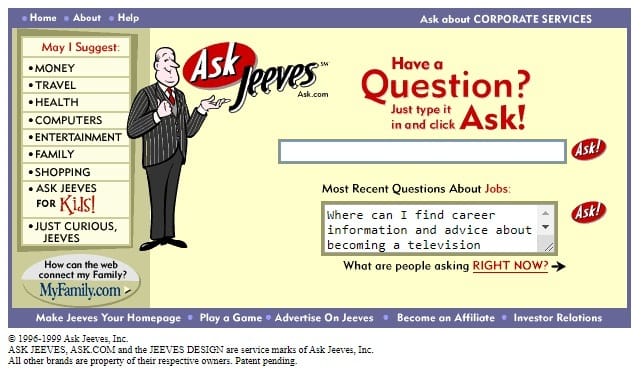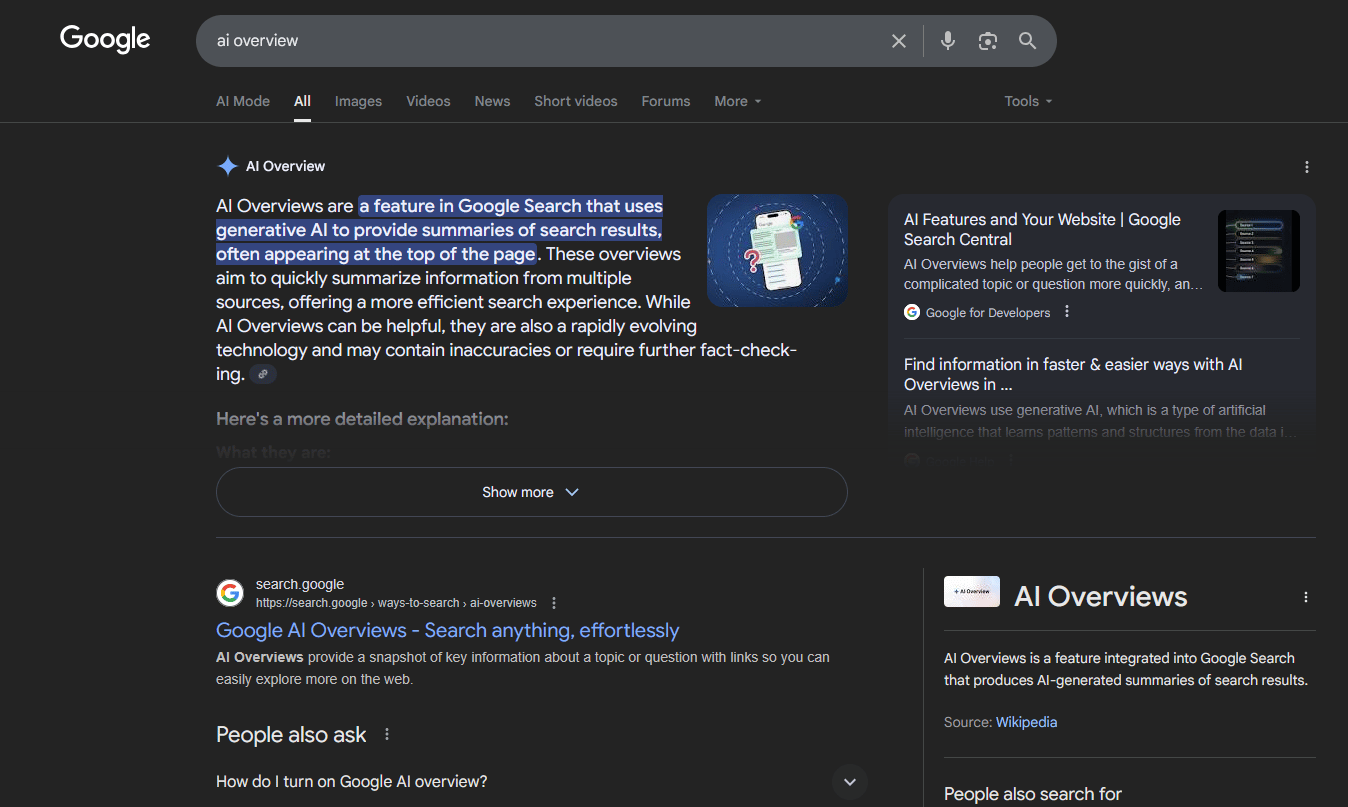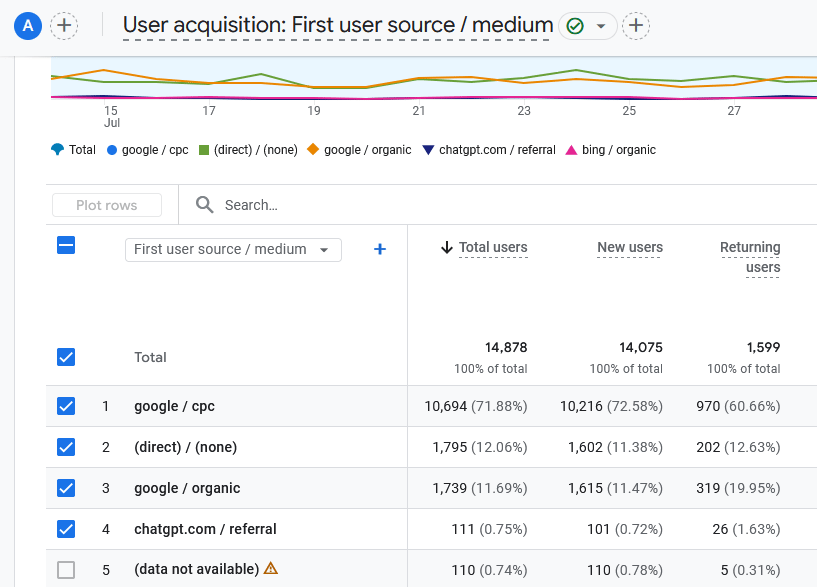Search engines feel like they’ve been around forever. But we all know this isn’t so.
Back in the late ’90s, you didn’t “Google it.” You asked Jeeves.
People typed out full questions like “How do I boil an egg?” or “What’s the best car for snow?”
And with formal aplomb, Jeeves answered your questions—until Ask.com popped with the dotcom bubble.

Then Google taught us to speak its language: “boil egg,” “best car snow.” For twenty years, we adapted to search like computers, not like people.
Now the pendulum is swinging back. Since ChatGPT launched in 2022, people are typing questions again. Long ones. With nuance.
Unlike Jeeves, this machine talks back, in natural(ish) language, no less. And with as many follow-up questions as you like.
Google had to play catchup for the first time in decades, so they launched Search Generative Experience (SGE). And now when you search for something, at the top of the page, you’ll see summaries, judgments, and recommendations. Often above links.
It’s the original promise of Jeeves, fulfilled at last.
But there’s a huge problem: a lot of businesses are seeing their traffic drop as a direct result. That’s a problem. And now marketers and business owners have to figure out what to do about it.
And to do that, we need to talk about how…
Like what you’re reading so far? Subscribe for more!
Search engines are turning into answer engines.
Answer engines are tools that pull from multiple sources, condense the findings, and give a single polished response without requiring a click.
Now if you’re a small- or mid-size business that relies on organic search, this is, frankly, scary as all hell. It means your pages can lose traffic—and leads—even while your pages “rank” in the algorithm.
This study from Search Engine Land in 2023 suggests that generative AI overviews on search can cut traffic anywhere from 18 to 64%. And, in my professional experience, this study has shown itself to be pretty accurate in the years that have followed.
That means people are getting answers straight from Google AI Overviews, to say nothing of ChatGPT, Perplexity, Claude, Bing Chat, Deepseek, or others. More and more people are making decisions without visiting company websites.
But there is also a consolation as well, as Search Engine Land also reported a 527% increase in LLM referral traffic across 19 websites—proof that these visitors are still finding websites, but through new means.
There’s a bourgeoning field right now called answer engine optimization (AEO) to deal with this. And it’s starting to edge out traditional rank-focused strategies. Instead of chasing position #1, the goal is to be the source AI models choose to quote. (See also: “large language model (LLM) seeding.”)
To do this, site owners are advised to use structured formatting, clean headers, and FAQ blocks. They’re advised to cite credible sources and signal experience, expertise, authoritativeness, and trustworthiness (E-E-A-T). That is, covering the topic thoroughly enough that an AI system can pull context and not just keywords.
This is all very important because it will help business owners continue to win traditional search engine traffic and boost their visibility in various AI systems. But I think that before I start rattling off solutions, we need to talk about a deeper question first.

How is AI changing search behavior?
People did not start using search engines because they wanted web pages. They used them because they wanted answers. And silly and nostalgic as my Jeeves metaphor may have seemed, I think that old avatar of the dotcom era is proof of this fact.
Case in point: search behavior is changing fast, and it’s not just a shift in where people click. More users are getting what they need without ever leaving the page. These are called zero-click searches, and they’re on the rise. The old SEO model—rank high, get the click—doesn’t hold up when the answer shows up before your link does.
That doesn’t mean traffic is gone. Like I said, search engines are still a huge source of traffic for websites and LLM-driven traffic is on the rise too.
It’s also worth pointing out that if someone wants what you’re selling, they still have to interact with you in some way, be it a phone call, email, purchase, or visit to your website. And visibility in search engines, even if it often results in a zero-click outcome, still makes all of these things more likely to happen (even if you can’t measure it).
I cannot stress this enough: there are lots of scenarios where your brand can get more impressions, fewer clicks, and the same (or more) leads or sales.
Consider this: queries are getting conversational. So if I’m looking for an email marketing vendor, for example, then instead of typing in keywords, I can type in a multi-sentence question that’s really specific. And rather than getting a list of “10 best email tools” and high-ranking vendors like Mailchimp and Klaviyo, I can ask 5 follow-up questions to make sure I’m really getting what I need.
Now, sure, I might very well end up going with Mailchimp or Klaviyo in the end after my AI-fueled research. But one of two things will happen as a result: I either go to one of the big vendors with less trepidation and uncertainty, or I find something off the beaten path because I’ve articulated a really specific problem that needs solving, and an AI happens to think this smaller vendor has the answer.
So if you’re running a small business, it might help to see the opportunity wrapped in the threat that is AI search. Instead of trying to outrank the big players, you need to become the answer to a really specific problem in the market.
This is why Google puts so much emphasis on E-E-A-T: because it wants its AI to summarize information that is of the highest quality available. And to do that, you have to provide context-rich, thoughtful content so that it, and its peers, knows it makes sense to match your company with its prospective customer.
But how do you actually do that?
How can small businesses adapt to AI SEO?
There are a lot of ways you can prepare your small business to take advantage of the changes that AI is making to way people search. Here are six ideas that come to mind:
1. Track where your traffic is really coming from.
If you’re seeing a drop in clicks but impressions are holding steady in Google Search Console, that’s a clue you’re being surfaced in an AI overview, but not getting a click. If you’re getting new traffic from chatbots, take note. According to Search Engine Land, LLM-driven referral traffic is growing fast, often miscategorized as "direct" in traditional analytics.

Ah, yes, it’s my old friend, (direct) / (none) 🫠
2. Make your content readable to AIs.
Don’t bury the answer to a simple question in paragraph four. Put a concise summary right at the top. Use clear headings, logical sections, and schema markup if relevant. Think more like a reference doc, less like a long narrative.
3. Optimize for selection, not just rank.
AI systems don’t care who’s #1 on Google. They care who’s trustworthy. That means real bylines, reputable sources, and expertise. E-E-A-T isn’t just a guideline anymore. It’s the criteria for getting quoted.
4. Make every page AI-ready.
AI might grab a snippet from your product page or FAQ, not just your blog. So every part of your site should be clear, accurate, and structured. If a support article has the best answer, it becomes the citation.
5. Publish what AI can’t replicate.
Chatbots regurgitate what’s already online. Your original data, case studies, and real-world stories are what stand out. If it’s yours alone, it’s valuable.
6. Don’t forget the basics.
Fast load times, clean code, and mobile responsiveness are still extremely important, as are clear calls to action and good UX. AI might change how people arrive, but it hasn’t changed why they stay.
And if you read the above and you’ve noticed that this isn’t too far off from traditional white-hat SEO, well, that’s kind of the beauty of it. After all, search engines want to send people to useful sites and AIs want to draw from useful sites. Their missions are not that different.
But that’s not to say that AI won’t further change SEO rules over time.
What does the future of AI SEO look like?
If you feel nervous, I sure don’t blame you. This big change doesn’t show any sign of stopping.
Google is continuing to roll out AI overviews more broadly. Maybe they’ll eventually find a way to make it work for local SEO too.
Microsoft is going to keep working AI into Bing. ChatGPT, Claude, and Perplexity are going to keep tending to their products and growing market share and loyal user bases of their own. And perhaps some competitors will pop up as well, even if one or two of the OGs go defunct.
But make no mistake: people will still search for information one way or another.

Before search engines, there were phone books. One way or another, people will get the info they seek.
Of course, your metrics will need to adapt. You won’t always be able to count clicks, since a lot of AI traffic will show up as “direct/none” in Google Analytics. Some of that traffic will disappear entirely due to zero-click searches, and you’ll probably want a way to track that too, be it Google Search Console or maybe SEMRush’s new AI visibility tools.
Over time, visibility and citations will increase in importance, so you will want to find ways to track that. You’ll want to know if your brand is showing up in summaries, getting mentioned, quoted, and linked.
And it’s important to not forget that other changes are happening simultaneously. Voice and visual search are continuing to get better too with tools like Google Lens and Siri. They’re not disruptive enough to make headlines these days, but their continued adoption is going to keep changing the way people search, little bit by little bit.
Finally, make no mistake about it: AIs are going to have to find a way to monetize too. Google is trying to find ways to work ads inside its AI answers. I wouldn’t be surprised if the unprofitable firm behind ChatGPT, OpenAI, started to do something similar.
The future will probably hold a mix of old-school organic search, sponsored search, conversational AI research, AI overviews on top of traditional search, paid AI results, voice search, and visual search. And yes, this kind of fragmented search is a lot harder to track that Google traffic alone would have been in the halcyon days of 2018!
But even still, two golden rules will remain:
Be the answer to a real problem.
Optimize for the metrics closest to revenue and profit.
If you do these two things and you move forward in a spirit of bold experimentation, I think you’ll come out of the AI SEO upheaval stronger than you went into it.
Final Thoughts
SEO isn’t dead. And it won’t die unless the concept of searching for answers itself does.
But you’d be making a big mistake if you didn’t bank on big changes. AI is already dramatically changing the way people search for answers, whether they use new tools like ChatGPT, or stick to established ones like Google.
And look, I won’t lie to you—if you’re putting all your eggs in the “organic search traffic” basket, you should reconsider. Because there’s a tremendous amount of opportunity out there if you’re willing to seize it.
If you are fast, clear, genuinely helpful, and your business is positioned to solve real problems had by real people, then you are well-positioned to stand out. Not just in the search engines, but in the AI systems that are reshaping how things are found on the internet.
Remember: the AIs have to get their answers from somewhere. And that could be you. So keep publishing content that helps people, and make sure you format it so machines can understand it. The machines, in turn, will do their best to help the people you’re trying to help.
As ever, the best defense a business can have is to make something worthwhile. The other half is showing up where your customers are already looking.
Need help marketing your business?
Or just need someone to bounce ideas off of?
Book 30 minutes with me and we can chat!
(Yes, it’s free.)
